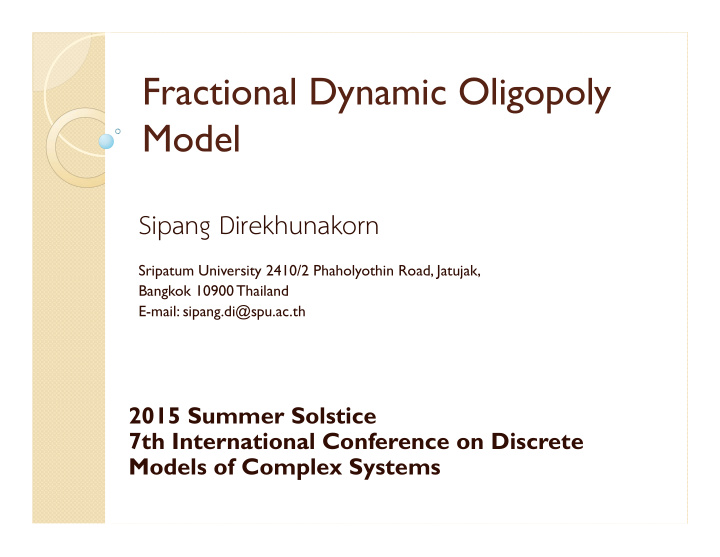



Fractional Dynamic Oligopoly Model Sipang Direkhunakorn Sripatum University 2410/2 Phaholyothin Road, Jatujak, Bangkok 10900 Thailand E-mail: sipang.di@spu.ac.th 2015 Summer Solstice 7th International Conference on Discrete Models of Complex Systems
Topics Logistics Model Fractional Calculus Complex Oligopoly Cournot duopoly model Best Response Dynamics Reaction function Adjustment process Fractional Discrete Map Numerical Results Conclusion
Logistic Equation
Logistic Model
Logistic model (Continuous time)
Plot of Logistic curve
Discrete Logistic function
Fractional Calculus The subject of fractional calculus is calculus of integrals and derivatives of any arbitrary real or complex order 300 year old mathematical topics The concept of fractional calculus is popularly believed to have stemmed from a question raised in the year 1695 by L'Hopital to Leibniz, which sought the meaning for the derivative of order n when n=1/2. Recently have applications in many fields
Definition of Gamma function
Grunwald-Letnikov Definition
Example of Fractional derivative
Example (cont)
Fractional-order Logistic
Complex oligopoly dynamics Original oligopoly model is in the form of linear function Recent studies of oligopoly model are in the forms of nonlinear function Nonlinear dynamical system many type of complexity arises include limit cycle, periodic doubling, strange attractor
Cournot Duopoly model Bischi et al., have introduced the discrete- time Cournot duopoly model with partial adjustment to the Best Response where the two firms in the model produce the same product. The equilibrium is described the strategy sets from which each firms choose their output quantities and the resulting instantaneous payoffs.
Cournot Duopoly model (cont) The Cournot reaction function are described by the quantities that their rival firms produced
Cournot tatonnement The Cournot tatonnement or Best Response Dynamic can now be described in terms of the reactions functions as where r 1 and r 2 are often referred to as Best Replies (or reaction functions).
Reaction function Bischi & Kopel type. Stackelberg leadership in which one firm becomes the leader by taking the reaction functions of the other firms Bischi and Kopel propose the reaction function in term of couple logistic function
Reaction Functions Each player sets the current output equal to the best response (i.e., current period pay-off maximizing choice) to the last period output of its opponent.
Adjustment process Bischi et al., have proposed the adjustment process in case that the firms are insecure if the forecasts of the opponent’s behavior is correct or if the decision making process involves some other thing then the firms may use an adjustment process which is described by
Generalize logistic function
Fractional Discrete map
Fractional Best Response Model By substitute generalize logistic function in Best Response Dynamic equation Substitute the logistic function in reaction function, then we have a iterative map T
Fractional Best Response Model By substitute the iterative map T with generalize logistic function then we obtained the new form of map
Example Fractional Map An example of fractional map for
Numerical results Present in the graphic form of phase space at different parameters sets There are different types of dynamical behaviour arise in duopoly model include periodic, limit cycle, and chaotic
Phase space of integer order
Phase space of fractional order
Conclusion We have study the dynamic of duopoly model where the reaction function described by logistic function further with fractional calculus. Two-dimensional duopoly phase space have present with different parameters. The numerical results are aimed to study behavior of duopoly at fractional-order compare to the integer- order. The graphical results of phase portrait are provided the behavior of the model range from limit-cycle, Hopf-type bifurcation and strange attractor. Theory of fractional calculus is feasible to examine different behavior at difference regime.
Recommend
More recommend